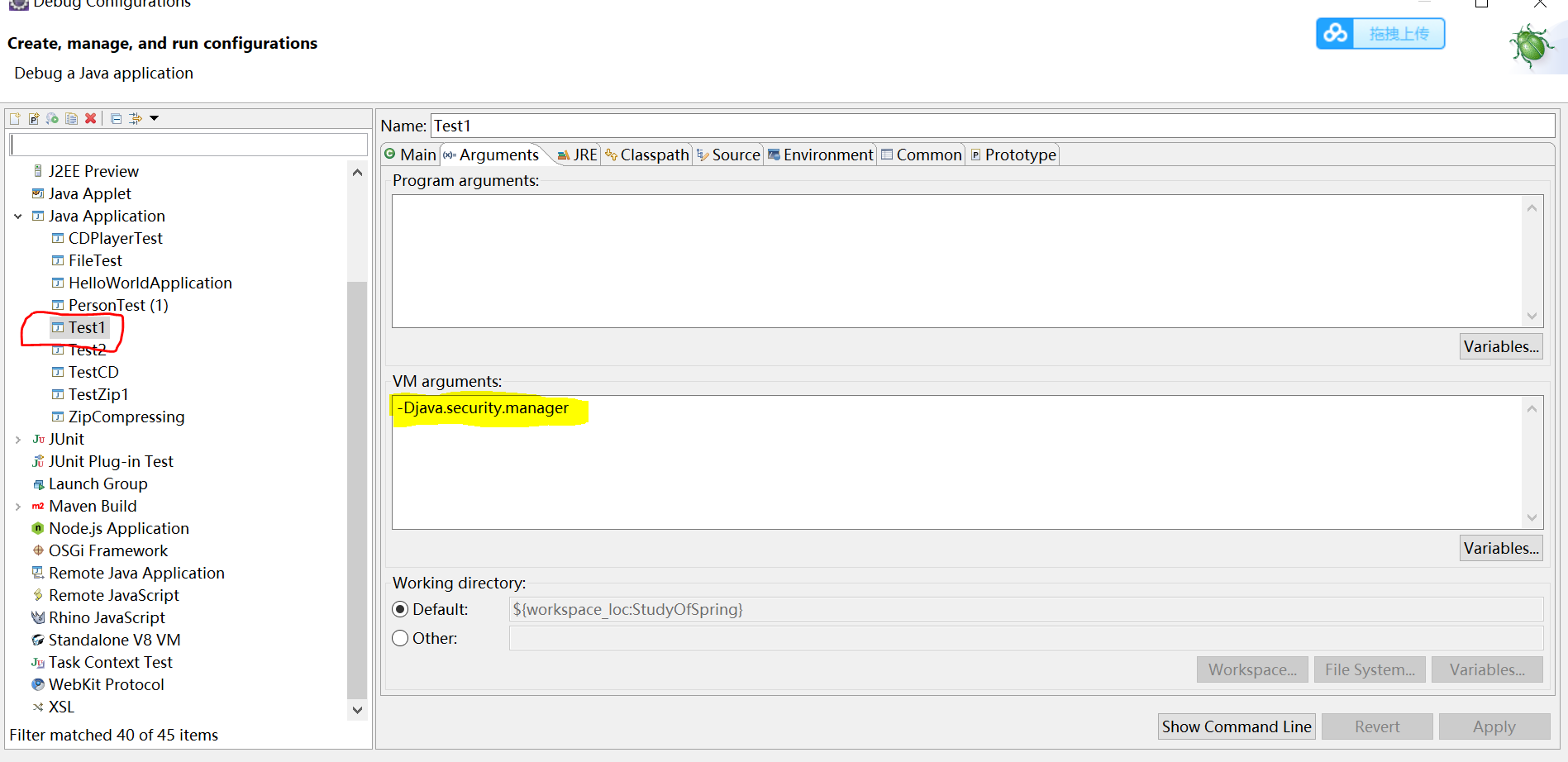一。FileInputStream属性:
/* File Descriptor - handle to the open file */
private final FileDescriptor fd;
/*用来标识输入流的状态*/
private final String path; //文件的路径信息
private FileChannel channel = null;
private final Object closeLock = new Object();//关闭时的同步锁
private volatile boolean closed = false;
二。FileInputStream重载了3个构造方法。能够通过以下三种方式初始输入流:
- public FileInputStream(String name) throws FileNotFoundException;
:以路径的方式初始一个输入流。其内部调用的是以下的构造方法
public FileInputStream(String name) throws FileNotFoundException { this(name != null ? new File(name) : null);//当name不为空,就生成一个File对象 作为FileInputStream(File file)构造函数的参数 }
- public FileInputStream(File file) throws FileNotFoundException;
:以File实例的方法初始一个输入流
源码为:

1 public FileInputStream(File file) throws FileNotFoundException { 2 String name = (file != null ? file.getPath() : null); 3 SecurityManager security = System.getSecurityManager(); 4 if (security != null) { 5 security.checkRead(name); 6 } 7 if (name == null) { 8 throw new NullPointerException(); 9 } 10 if (file.isInvalid()) { 11 throw new FileNotFoundException("Invalid file path"); 12 } 13 fd = new FileDescriptor(); 14 fd.attach(this); 15 path = name; 16 open(name); 17 }
构造方法内部解析:
SecurityManager security = System.getSecurityManager();
其中 当运行未知的Java程序的时候,该程序可能有恶意代码(删除系统文件、重启系统等),为了防止运行恶意代码对系统产生影响,需要对运行的代码的权限进行控制,这时候就要启用Java安全管理器(SecurityManager)。
1.默认的安全管理器配置文件是 $JAVA_HOME/jre/lib/security/java.policy,即当未指定配置文件时,将会使用该配置。
使用之前需要启动SecurityManager,启动有两种方式:参数方式、编码方式
启动程序的时候通过附加参数启动安全管理器:
-Djava.security.manager
若要同时指定配置文件的位置那么示例如下:
-Djava.security.manager -Djava.security.policy="E:/java.policy"
"="表示这个策略文件将和默认的策略文件一同发挥作用; "=="表示只使用指定的策略文件 。如 -Djava.security.policy==E:/temp/test1.policy或者 -Djava.security.policy=bin/com/test/test1.policy
编码方式(不建议):
System.setSecurityManager(new SecurityManager());
参数方式启动:

保存后在运行security就不为null了 ,走进security.checkRead(name); 抛错(使用了默认配置文件)

这时候解决方式:(1)关闭安全管理器;(2)赋予该程序读取文件权限
打开管理器配置文件添加:
grant { permission java.io.FilePermission "C:\\Study\\*", "read"; permission java.io.FilePermission "C:\\Study\\2401.jpg_wh1200.jpg", "write"; };
给程序添加文件读权限
其中 permission java.io.FilePermission "C:\Study\2401.jpg_wh1200.jpg", "read"; 一个反斜杠是错误的
权限项中出现的项目必须按指定顺序出现(permission,permission_class_name,”target_name”,”action” 和 signedBy “signer_names”)。分号表示项终止。
大小写对于标识符(permission、signedBy、codeBase 等)来说并不重要,但对于 permission_class_name 或作为值传递过来的字符串而言就很重要了。
有关 Windows 系统上文件路径规范的注意事项
请注意:在指定 java.io.FilePermission 时,”target_name” 是文件路径。在 Windows 系统上,无论何时在字符串中(而不是在 codeBase URL 中)直接指定文件路径,路径中都需要两个反斜杠来代表一个实际的反斜杠;
- public FileInputStream(FileDescriptor fdObj);
:以FileDescriptor实例初始一个输入流(FileDescriptor是一个文件描写叙述符
FileDescriptor:文件描述符类的实例用作表示打开文件,开放套接字或其他字节源或信宿的底层机器特定结构的不透明句柄。 文件描述符的主要实际用途是创建一个FileInputStream或FileOutputStream来包含它。
三。FileInputStream方法
int |
available()
返回从此输入流中可以读取(或跳过)的剩余字节数的估计值,而不会被下一次调用此输入流的方法阻塞。
|
|
void |
close()
关闭此文件输入流并释放与流相关联的任何系统资源。
|
|
protected void |
finalize()
确保当这个文件输入流的
close方法没有更多的引用时被调用。
|
|
FileChannel |
getChannel()
返回与此文件输入流相关联的唯一的
FileChannel对象。
|
关于FileChannel可以参考以上博客 |
FileDescriptor |
getFD()
返回表示与此
FileInputStream正在使用的文件系统中实际文件的连接的
FileDescriptor对象。
|
|
int |
read()
从该输入流读取一个字节的数据。
|
|
int |
read(byte[] b)
从该输入流读取最多
b.length个字节的数据为字节数组。
|
|
int |
read(byte[] b, int off, int len)
从该输入流读取最多
len字节的数据为字节数组。
|
|
long |
skip(long n)
跳过并从输入流中丢弃
n字节的数据。
|
available():要一次读取多个字节时,经常用到InputStream.available()方法,这个方法可以在读写操作前先得知数据流里有多少个字节可以读取。需要注意的是,如果这个方法用在从本地文件读取数据时,一般不会遇到问题,但如果是用于网络操作,就经常会遇到一些麻烦。比如,Socket通讯时,对方明明发来了1000个字节,但是自己的程序调用available()方法却只得到900,或者100,甚至是0,感觉有点莫名其妙,怎么也找不到原因。其实,这是因为网络通讯往往是间断性的,一串字节往往分几批进行发送。本地程序调用available()方法有时得到0,这可能是对方还没有响应,也可能是对方已经响应了,但是数据还没有送达本地。对方发送了1000个字节给你,也许分成3批到达,这你就要调用3次available()方法才能将数据总数全部得到。能否使用取决于实现了InputStream这个抽象类的具体子类中有没有实现available这个方法。如果实现了那么就可以取得大小,如果没有实现那么就获取不到。例如FileInputStream就实现了available方法,那么就可以用new byte[in.available()];这种方式。但是,网络编程的时候Socket中取到的InputStream,就没有实现这个方法,那么就不可以使用这种方式创建数组。
public static void main(String[] args) { String name="C:\\Study\\2401.jpg_wh1200.jpg"; // inputStream(); /*Person per=new Student(); per.doSomething();*/ FileInputStream fis=null; try { File file=new File(name); fis=new FileInputStream(file); int available = fis.available(); System.out.println(available); long n=500000; fis.skip(n); int available2 = fis.available(); System.out.println("available2 is "+available2 ); } catch (FileNotFoundException e) { // TODO Auto-generated catch block e.printStackTrace(); } catch (IOException e1) { e1.printStackTrace(); }finally { if(fis!= null) { try { fis.close(); } catch (IOException e) { e.printStackTrace(); } } } }
控制台执行结果:
532598
available2 is 32598
read()方法:从此输入流中每次只读取读取一个数据字节。如果没有输入可用,则此方法将阻塞。 指定者:类 InputStream 中的 read 返回:下一个数据字节;如果已到达文件末尾,则返回 -1。
1、此方法是从输入流中读取一个数据的字节,效率会非常低,更好的方法是用InputStream.read(byte[] b)或者InputStream.read(byte[] b,int off,int len)方法,一次读取多个字节。通俗点讲,即每调用一次read方法,从FileInputStream中读取一个字节。
2、返回下一个数据字节,如果已达到文件末尾,返回-1,这点除看难以理解,通过代码测试理解不难。
3、如果没有输入可用,则此方法将阻塞。这不用多解释,大家在学习的时候,用到的Scannner sc = new Scanner(System.in);其中System.in就是InputStream(为什么?不明白的,请到System.class查阅in是个什么东西!!),大家都深有体会,执行到此句代码时,将等待用户输入 摘自 JAVA-FileInputStream之read方法 博客
本地测试代码如下:
public class Test1 { private static String name="C:\\Study\\output.txt"; @Test public void Test1() { FileInputStream file=null; int i=0; //调用read()次数 try { file=new FileInputStream(name); int read =0; System.out.println("available is :"+file.available());// while(read != -1) {返回从此输入流中可以读取(或跳过)的剩余字节数的估计值 该文件输入流值为:68 read= file.read(); i++; System.out.println(read+" and i="+i); } } catch (FileNotFoundException e) { e.printStackTrace(); }catch (IOException e) { e.printStackTrace(); }finally { if( file != null ) { try { file.close(); } catch (IOException e) { // TODO Auto-generated catch block e.printStackTrace(); } } } } }
控制台输出结果为:

available is :68 228 and i=1 189 and i=2 160 and i=3 229 and i=4 165 and i=5 189 and i=6 239 and i=7 188 and i=8 140 and i=9 230 and i=10 136 and i=11 145 and i=12 230 and i=13 152 and i=14 175 and i=15 229 and i=16 188 and i=17 160 and i=18 228 and i=19 184 and i=20 137 and i=21 32 and i=22 230 and i=23 136 and i=24 145 and i=25 228 and i=26 187 and i=27 138 and i=28 229 and i=29 164 and i=30 169 and i=31 229 and i=32 190 and i=33 136 and i=34 229 and i=35 188 and i=36 128 and i=37 229 and i=38 191 and i=39 131 and i=40 229 and i=41 146 and i=42 140 and i=43 228 and i=44 189 and i=45 160 and i=46 231 and i=47 186 and i=48 166 and i=49 228 and i=50 188 and i=51 154 and i=52 32 and i=53 232 and i=54 175 and i=55 183 and i=56 229 and i=57 164 and i=58 154 and i=59 229 and i=60 164 and i=61 154 and i=62 230 and i=63 140 and i=64 135 and i=65 230 and i=66 149 and i=67 153 and i=68 -1 and i=69
- private static native void initIDs();
- private native void close0() throws IOException;
- private native void open0(String name) throws FileNotFoundException; :打开文件
- private native int read0() throws IOException; :读取一个字节
- private native int readBytes(byte b[], int off, int len) throws IOException; :读取指定字节数
- public native long skip(long n) throws IOException; 丢弃指定字节,下次读取时,从丢弃后的位置開始读取
- public native int available() throws IOException;
FileInputStream内部,有几个native类型的方法,用于调用底层语言来完整对于文件系统的操作:
FileInputStream流类内部提供了一种对于文件操作的机制,可是因为Java语言的局限,FileInputStream须要通过native方法调用底层语言实现。
